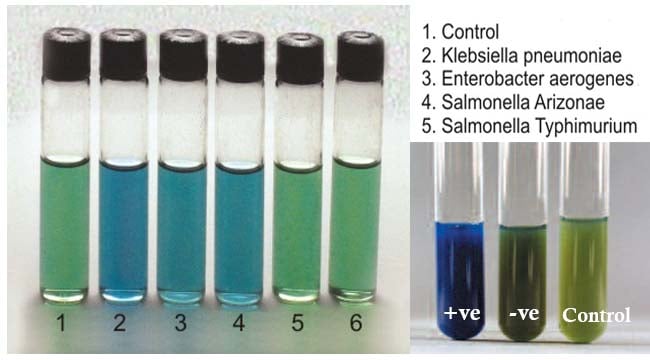Interesting Science Videos
Objectives of Malonate Test
- To test the ability of the organism to utilize malonate as sole source of carbon.
- The Malonate Test was originally designed to differentiate between Escherichia, which will not grow in the medium, and Enterobacter.
- Its use as a differential medium has now broadened to include other members of Enterobacteriaceae.
Principle of Malonate Test
An organism that simultaneously can utilize sodium malonate as its carbon source and ammonium sulfate as its nitrogen source produces an alkalinity due to the formation of sodium hydroxide. The medium used for malonate utilization test is malonate broth. It contains mineral salts, sodium malonate for carbon, and ammonium sulfate for its nitrogen source. The pH indicator is bromothymol blue, which is green at neutral pH, yellow at acidic pH <6.0 and turns blue at alkaline (basic) pH >7.6. Organisms which simultaneously utilize malonate and ammonium sulfate produce sodium hydroxide which thereby results in an alkaline reaction and changes the indicator from its original green color to light blue or Prussian blue. Organisms which cannot utilize malonate and ammonium sulfate and do not ferment dextrose produce no color change. Organisms which are malonate-negative but do ferment dextrose result in the development of a yellow color due to increased acidity in the medium.
Media Used in Malonate Test
Malonate broth (1000 ml)
| Sodium Malonate | 3.0gm |
| Ammonium Sulfate | 2.0gm |
| Sodium Chloride | 2.0gm |
| Yeast Extract | 1.0gm |
| Dipotassium Phosphate | 0.6gm |
| Monopotassium Phosphate | 0.4gm |
| Dextrose | 0.25gm |
| Bromothymol Blue | 0.025gm |
Final pH 6.7 +/- 0.2 at 25ºC.
Procedure of Malonate Test
- Inoculate the tube containing malonate broth with 18-24 hours pure culture of the organism.
- Incubate the tube with loosened caps at 35ºC in an aerobic atmosphere for 24-48 hours.
- Observe for color change in the medium.
Result Interpretation of Malonate Test

Positive test: development of a blue color in the medium
Negative test: media remains green or turns yellow due to dextrose fermentation
Limitations of Malonate Test
- The test organisms must be in pure culture and 18-24 hours old.
- Some malonate-positive organisms produce only a slight alkalinity which renders difficulty in interpretation. Questionable and doubtful results should be compared with an uninoculated malonate tube. Any trace of blue color is indicative of a positive test after 48 hours of incubation.
- Yeast extract and glucose are needed to stimulate growth of some Salmonella
organisms but are not generally necessary for other species.
Quality Control of Malonate Test
Klebsiella pneumoniae, ATCC13883- positive test, broth turns deep blue.
Escherichia coli, ATCC25922- negative test, broth remains green.
